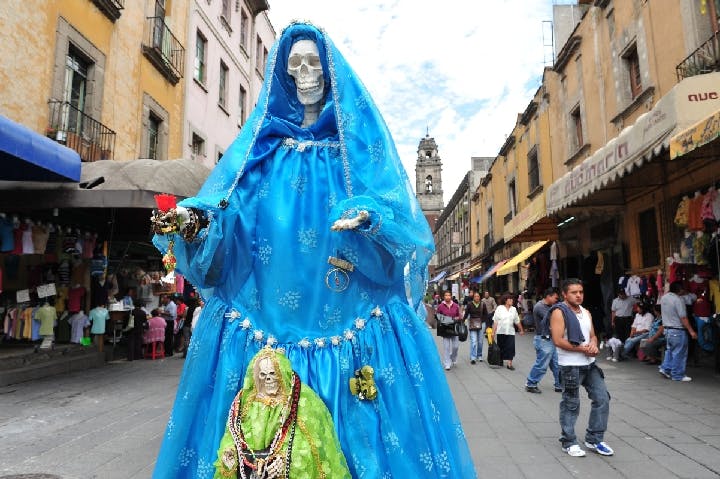Behind Mexico’s Cult of the Skeleton Saint
– Carlo Massimo
La Santa Muerte, Saint Death, has protected the faithful in Mexico’s violent underworld for decades. But research is revealing her to be less of a criminal’s saint, and more a ghost of NAFTA.
In Mexico, she’s unmistakable: a hideous skeleton, veiled like the ubiquitous Virgin of Guadalupe, on whose altars the faithful light candles and say rosaries. She’s said to protect thieves and drug traffickers; her supplicants call on her for protection in jail, and sometimes for revenge.
La Santa Muerte was first documented in the Mexican prison system in the 1990s, and is believed to have thrived there for half a century. It was only in 2001, when a Mexico City housewife erected a sidewalk shrine to the skeleton saint, that Saint Death’s irresistibly macabre appeal swept the world. Unrecognized and rejected by the Catholic Church, she is a folk saint in the purest sense. Her lineage traces back, it seems, to the rich afterlife traditions of indigenous Mexico, the pre-Columbian cult of death, and the lively, sumptuous Día de los Muertos celebrations.
La Santa Muerte is becoming a fixture of daily life across Mexico, but especially in those neighborhoods of Mexico City where crime, violence, and police corruption thrive. Books and film (including a documentary starring Gael García Bernal), entranced by her ghoulish mystique, have introduced her to the world as a criminal’s saint, the apotheosis of Mexico’s bloody drug wars and grim, everyday violence.
But perhaps the explanation of la Santa Muerte as violence incarnate is a little simplistic. Based on quantitative and qualitative research, a paper in the Journal of Latin American Studies found that Saint Death’s appeal is neither highest among the thieves, smugglers, and felons of Mexico, as popular belief would have it, nor among simply the poorest classes. She turns out to be rather domestic — a figure of family and feminine reassurance, as maternal as she is gruesome, who offers a way for people to orient themselves morally in a world of unpredictable economics and fierce violence, where good and evil share a hazy, porous border.
The year 2001, when la Santa Muerte first appeared on Mexico’s national radar, was a critical time for Mexico City. Mexico had signed NAFTA only seven years before; New York mayor-turned-security consultant Rudy Giuliani would soon unveil his heavy-fisted “zero tolerance” plan for the Mexico City police. And while some sectors of the Mexican economy prospered, others reeled from major blows: shrinking domestic industries, farmers priced out of food markets, and declines in wages for working Mexicans.
Street vendors and cab drivers in particular, either unable to comply with complicated new regulations or worried by a flagging economy, turned to smuggling and other criminal enterprises. In turn, they filled out the already overcrowded cells of Mexico’s prisons, where the cult of la Santa Muerte attracted legions of new followers. Not coincidentally, the study found that the highest density of shrines to la Sante Muerte were near informal street markets, where vendors hawk everything from kitchen appliances to drugs — where, effectively, criminals are created.
Women especially are faithful to la Sante Muerte, and bound by special connection to her. The Journal study’s participants commonly referred to her as “mother,” “godmother,” or “little sister.” The wives, daughters, and sisters of incarcerated men frequently face the challenges of running a household alone, piloting between an unsympathetic law enforcement and the world of crime. The families of policemen face similar dilemmas. La Santa Muerte is not exclusively a prisoner’s saint; prison guards, wardens, and policemen are no less faithful than the men on the other side of the bars.
In a city where working families can plunge abruptly into poverty, where crooked cops and honest policemen can hardly be distinguished, and where virtuous men ply criminal trades, the border between right and wrong looks more and more like another border: Mexico’s border with the U.S., where money, people, and commodities, legal and illicit, flow continuously north and south. La Santa Muerte, kind and ghastly, nurturing and murderous, encapsulates the ambiguity of life in a country that exists as a single, vast, border.
* * *
The Source: Regnar Albæk Kristensen, “La Santa Muerte in Mexico City: The Cult and its Ambiguities,” The Journal of Latin American Studies. First View, 2015
Cover photo courtesy of Shutterstock/ChameleonsEye
